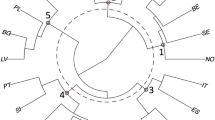Abstract
This paper leads to apply some recent developments in the economic literature dealing with the concept of innovation systems to the problem of economic cohesion in Europe. Starting from a definition of innovation systems, it allows to consider firms and sets of intstitutions as two main but different types of innovation systems. This distinction is the source of a discussion about the nature of the coordination problems which appear when considering the European diversity of innovation systems. The different combinations between innovation systems developed in the paper are a useful means of discussing European policy intervention and its ability to favour (or not) economic cohesion.
Similar content being viewed by others
References
Amendola M., Bruno S., 1990, The Behaviour of the Innovative Firm: Relations to the Environment, inResearch Policy, 19, p.419–433
Amendola M., Gaffard J.L., 1988,The Innovative Choice: an economic analysis of the dynamics of technology, Basil Blackwell, Oxford.
Aoki M., 1988,Information, Incentive and Bargaining in the Japanese Economy, Cambridge University Press
Aoki M., 1990, “Toward an Economic Model of the Japanese Firm”,in Journal of Economic Literature, vol XXVIII, p.1–27.
Bianchi P., Bellini N., 1991, Public policies for local networks of innovators, inResearch Policy, No 20, p.487–497
Bianchi P., Miller L., 1992, Systems of Innovation and the EC Policy-Making Approach, contribution to the International Conference on Systems of Innovation, Bologna, 1992, October 5–6
Bruno S., 1993, Boosting European growth: strategies for integration and strategies for competition, Contribution to the International Conference “The European Periphery Facing the New Century”, Santiago de Compostela, Spain, October 1–2
Bruno S., De Lellis A., 1992, The Innovative Systems: The Economics of “ex ante” Coordination, contribution to the International Conference on Systems of Innovation, Bologna, 1992, October 5–6
Charbit C., Gaffard J.L., Longhi C., Perrin J.C., Quere M., Ravix J.L., 1991,Coherence and Diversity of system of innovation: the study of local system of innovation in Europe, Working paper FAST - FOP 235, Vol.11, DG XII, MONITOR/FAST Programme, Commission of the European Communities
Dosi G., 1988, “Sources, Procedures and Microeconomic Effects of Innovation”, inJournal of Economic Literature, 26, p.1120–1171.
Dosi G., Freeman C., Nelson R., Silverberg G., Soete L. Eds., 1988,Technical change and economic theory, Pinter Publishers, London.
Dosi G., Teece D., Winter S., 1990, “Les Frontières des Entreprises: vers une théorie de la cohérence de la grande entreprise”, inRevue d'Economie Industrielle, 51, p. 238–54.
Ergas H., 1987, “The importance of technology policy”, in Dasgupta and Stoneman ed.,Economic policy and technological performance, Cambridge University Press, Cambridge, p.51–96
Freeman C., 1987,Technology Policy and Economic Performance, Pinter Publishers, London and New-York
Gaffard J.L. and alii, 1987,La création de technologies, stratégies d'entreprises et politiques publiques, Programme de recherches Technopoles et Développement, CNRS-LATAPSES, Sophia-Antipolis
Gaffard J.L., 1990, “Innovations et changements structurels”, inRevue d'Economie Politique, 100 (3), p.325–382
Gaffard J.-L., Bruno S., Longhi C., Quere M., 1993,Coherence et diversité des systèmes d'innovation en Europe: éléments d'analyse et de politiques économiques, Working paper FAST - FOP 349, Vol.19, DG XII, MONITOR/FAST Programme, Commission of the European Communities
GREMI, 1986,Milieux innovateurs en Europe, Aydalot P. ed., GREMI, Paris
Hart O., Holmstrom B., 1987, The Theory of Contracts, inAdvances in Economic Theory, Trueman Bewley Eds, Cambridge University Press
Hicks J.R., 1973,Capital and time, Clarendon Press, Oxford.
Imai K., Itami H., 1984, “Interpenetration of Organization and Market”, inInternational Journal of Industrial organisation, August, p.285–310
Imai K., Baba Y., 1989, “Systemic Innovation and Cross-Border Networks: Transcending Markets and Hierarchies to Create a New Techno-Economic System”, Paper presented at the International Seminar on Science, Technology and Economic Growth, OECD, Paris.
Kline S., Rosenberg N., 1986, “An overview of innovation”, in R. Landau, N. Rosenberg, Eds,The Positive Sum Strategy, Academy of Engineering Press, p. 275–305
Longhi C., Quere M., 1993, “Systémes de production et d'innovation, et dynamiques des territoires”, inRevue Economique, Vol. 44, July, p.713–724
Lundvall B.A., 1988, “Innovation as an interactive process: from user-producer interaction to the national system of innovation”, inDosi andAlii, Technical Change and Economic Theory, Pinter Publishers, London and New-York, p.349–369
Lundvall B.A., 1992,National Systems of Innovation — Toward a Theory of Innovation and Interactive Learning, Pinter Publishers, London and New York
Nelson R., Winter S., 1982,An Evolutionary Theory of Economic Change, Belknap Press of Harvard University, Cambridge, Mass.
Nelson R., 1993,National Systems of Innovation — Case Studies, Oxford University Press
Patel P., Pavitt K., 1993, “National Systems of Innovation: Why they are important, and how they might be assessed?”, Working Paper No 93/05, CNRS-LATAPSES, Sophia-Antipolis
Pavitt K., 1991, “Key Characteristics of the large innovating firm”, inBritish Journal of Management 2, p. 41–50
Perrin J.C., 1991, “Stratégies environnementales des entreprises innovantes et formes de territorialisation industrielle”, inGREMI, Entreprises innovantes et développement local, Eresa-Economica, Paris
Simon H.A., 1962, The Architecture of Complexity,Proceedings of the American Philosophical Society, V. 196, No 6, December, p.467–482
Teece D., 1988, “Technological Change and the Nature of the Firm”, in G. Dosi et Alii Eds,Technical Change and Economic Theory, Pinter Publishers, London.
Tirole J., 1990,The Theory of Industrial Organization, MIT Press
Author information
Authors and Affiliations
Rights and permissions
About this article
Cite this article
Quéré, M. Economic cohesion and innovation systems in Europe. AI & Soc 8, 131–141 (1994). https://doi.org/10.1007/BF02064278
Issue Date:
DOI: https://doi.org/10.1007/BF02064278




